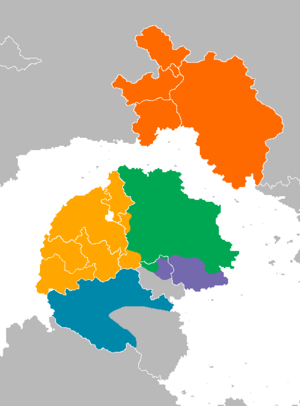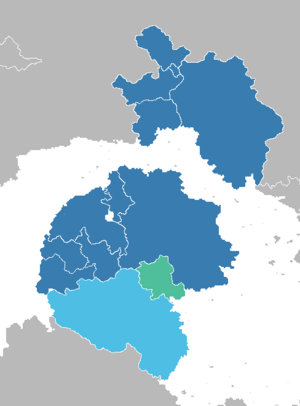Ashno-Verethian languages: Difference between revisions
mNo edit summary |
No edit summary |
||
| (One intermediate revision by the same user not shown) | |||
| Line 2: | Line 2: | ||
|name = Ashno-Verethian |
|name = Ashno-Verethian |
||
|region = Pre-colonial era: Northern [[Etzavaz]] and Southern [[Ashnan]]<br/> |
|region = Pre-colonial era: Northern [[Etzavaz]] and Southern [[Ashnan]]<br/> |
||
| − | {{small| |
+ | {{small|~400 million native speakers}} |
|family = One of the world's primary [[List of language families|language families]] |
|family = One of the world's primary [[List of language families|language families]] |
||
|familycolor = Ashno-Verethian |
|familycolor = Ashno-Verethian |
||
| Line 29: | Line 29: | ||
All Ashno-Verethian languages are descended from a single ancestor language, linguistically reconstructed as [[Proto-Ashno-Verethian]], spoken sometime in the [[Human history|Neolithic to Early Bronze Age]]. The geographical location where it was spoken, the [[Proto-Ashno-Verethian culture|Ashno-Verethian homeland]], has been the object of many competing hypotheses; the common consensus supports the Shtigu hypothesis, which posits the homeland to be the [[Shtigu River]] basin in what is now [[Teshkasta]] and [[Menkhemon]]. By the time the first written records appeared, Ashno-Verethian had already evolved into numerous languages spoken across much of Etzavaz and Western Ashnan. Written evidence of Ashno-Verethian appeared during the late Iron Age in the form of Arthan. The [[Arthan alphabet]] is one of the oldest known writing systems across the [[Four Seas]] region, descending from [[Marphat script|Marphat logograms]]. |
All Ashno-Verethian languages are descended from a single ancestor language, linguistically reconstructed as [[Proto-Ashno-Verethian]], spoken sometime in the [[Human history|Neolithic to Early Bronze Age]]. The geographical location where it was spoken, the [[Proto-Ashno-Verethian culture|Ashno-Verethian homeland]], has been the object of many competing hypotheses; the common consensus supports the Shtigu hypothesis, which posits the homeland to be the [[Shtigu River]] basin in what is now [[Teshkasta]] and [[Menkhemon]]. By the time the first written records appeared, Ashno-Verethian had already evolved into numerous languages spoken across much of Etzavaz and Western Ashnan. Written evidence of Ashno-Verethian appeared during the late Iron Age in the form of Arthan. The [[Arthan alphabet]] is one of the oldest known writing systems across the [[Four Seas]] region, descending from [[Marphat script|Marphat logograms]]. |
||
| + | |||
| + | ==Classification== |
||
| + | {{tree list}} |
||
| + | * '''Ashno-Verethian''' |
||
| + | ** [[Verethian languages|Verethian]] |
||
| + | *** [[Eastern Verethian languages|Eastern Verethian]] |
||
| + | **** [[Dirhassian language|Dirhassian]] |
||
| + | **** [[Ezhepairi language|Ezhepairi]]† |
||
| + | **** [[Vordosi language|Vordosi]]† |
||
| + | **** [[Fashāsahi language|Fashāsahi]]† (classification debated) |
||
| + | *** [[Western Verethian languages|Western Verethian]] |
||
| + | **** [[Old High Hashdezi|Hashdezic]] |
||
| + | ***** [[Hashdezi language|Hashdezi]] |
||
| + | ***** [[Agisian language|Agisian]] |
||
| + | **** [[Vezdali language|Vezdali]] |
||
| + | **** [[Sydian language|Sydian]] |
||
| + | *** [[Southern Verethian languages|Southern Verethian]] |
||
| + | **** [[Talozhi language|Talozhi]] |
||
| + | **** [[Mesvadi language|Mesvadi]] |
||
| + | *** [[Cernian language|Cernian]] |
||
| + | **** [[East Cernian]] |
||
| + | **** [[West Cernian]] |
||
| + | ** [[Ashno-Angkat languages|Ashno-Angkat]] |
||
| + | *** [[High Angkat language|Angkat]] |
||
| + | **** [[Erayi language|Erayi]] |
||
| + | ***** [[Modern Standard Erayi]] |
||
| + | ***** [[Menkhemon Erayi]] |
||
| + | ***** [[Sakhasta Erayi]] |
||
| + | ***** [[Teshkasta Erayi]] |
||
| + | ***** [[Hehagho Erayi]] |
||
| + | **** [[Sakhi language|Sakhi]] |
||
| + | *** [[Shoghashti language|Shoghashti]]† |
||
| + | ** [[Arthan language|Arthan]]† |
||
| + | {{tree list/end}} |
||
| + | |||
| + | ==History== |
||
| + | |||
| + | ==Features== |
||
| + | ===Phonology=== |
||
| + | ===Grammar=== |
||
| + | ===Selected cognates=== |
||
| + | {| class="wikitable" |
||
| + | ! [[Proto-Ashno-Verethian language|Proto-Ashno-Verethian]] |
||
| + | ! [[Dirhassian language|Dirhassian]] |
||
| + | ! [[Hashdezi language|Hashdezi]] |
||
| + | ! [[Agisian language|Agisian]] |
||
| + | ! [[Vezdali language|Vezdali]] |
||
| + | ! [[Sydian language|Sydian]] |
||
| + | ! [[Talozhi language|Talozhi]] |
||
| + | ! [[Mesvadi language|Mesvadi]] |
||
| + | ! [[Cernian language|Cernian (East)]] |
||
| + | ! [[Erayi language|Erayi]] |
||
| + | ! [[Shoghashti language|Shoghashti]] |
||
| + | ! [[Arthan language|Arthan]] |
||
| + | |- |
||
| + | ! ''*tʼiˀiʟat''<br>(cat) |
||
| + | | {{cs|vrt|ciiö}} (''cijö'') |
||
| + | | {{cs|vrt|cidds}} (''cidds'') |
||
| + | | {{cs|vrt|cigd}} (''cigd'') |
||
| + | | {{cs|vrt|tzei}} (''tzey'') |
||
| + | | {{cs|vrt|ciels}} (''ciels'') |
||
| + | | {{cs|vrt|cän}} (''cën'') |
||
| + | | |
||
| + | | {{cs|vrt|þíoal}} (''ṭiival'') |
||
| + | | ''tixos'' |
||
| + | | ''tīγaδ'' |
||
| + | | ''tíłath'' |
||
| + | |- |
||
| + | ! ''*balVw-jəw''<br>(fire) |
||
| + | | {{cs|vrt|olź}} (''olź'') |
||
| + | | {{cs|vrt|ooadzos}} (''wadzos'') |
||
| + | | {{cs|vrt|oadyz}} (''vadyz'') |
||
| + | | {{cs|vrt|oäza}} (''væza'') |
||
| + | | {{cs|vrt|oaluss}} (''valuss'') |
||
| + | | {{cs|vrt|oaluź}} (''valuž'') |
||
| + | | |
||
| + | | |
||
| + | | n/a |
||
| + | | ''pažoyō'' |
||
| + | | ''bałyâ'' |
||
| + | |- |
||
| + | ! ''*pʰariˀVlətʰ-''<br>(food) |
||
| + | | {{cs|vrt|oźals}} (''oźals'') |
||
| + | | {{cs|vrt|oajt}} (''vajt'') |
||
| + | | {{cs|vrt|oajät}} (''vajæt'') |
||
| + | | {{cs|vrt|fałzeða}} (''fallzeða'') |
||
| + | | {{cs|vrt|oielðy}} (''vielðy'') |
||
| + | | X (''fařalyš'') |
||
| + | | |
||
| + | | |
||
| + | | ''polizidh'' |
||
| + | | ''bazīžed'' |
||
| + | | ''p'arílet''' |
||
| + | |} |
||
[[Category:Language families]] |
[[Category:Language families]] |
||
Latest revision as of 04:04, 9 November 2025
| Ashno-Verethian | |
|---|---|
| Geographic distribution | Pre-colonial era: Northern Etzavaz and Southern Ashnan ~400 million native speakers |
| Linguistic classification | One of the world's primary language families |
| Proto-language | Proto-Ashno-Verethian |
| Subdivisions | |
 Present-day distribution of Ashno-Verethian languages in Etzavaz and Ashnan:
Ashno-Angkat
Cernian
Eastern Verethian
Southern Verethian
Western Verethian | |
 Countries where an Ashno-Verethian language has official status has co-official status is recognized as a minority | |
The Ashno-Verethian languages are a language family native to the northern half of Etzavaz as well as the Eranosphere. Some languages of this family—namely Hashdezi—have expanded through colonialism in the modern period and are now spoken across several continents. The Ashno-Verethian family is divided into several branches or sub-families, of which there are two main groups with languages still alive today: Ashno-Angkat and Verethian; one branch, Arthan, is now extinct. The Verethian sub-family is further subdivided into four groups: Cernian, Eastern Verethian, Southern Verethian and Western Verethian.
Today, the individual Ashno-Verethian languages with the most native speakers are Erayi, Dirhassian and Hashdezi each with over 50 million native speakers; many others are small and in danger of extinction.
All Ashno-Verethian languages are descended from a single ancestor language, linguistically reconstructed as Proto-Ashno-Verethian, spoken sometime in the Neolithic to Early Bronze Age. The geographical location where it was spoken, the Ashno-Verethian homeland, has been the object of many competing hypotheses; the common consensus supports the Shtigu hypothesis, which posits the homeland to be the Shtigu River basin in what is now Teshkasta and Menkhemon. By the time the first written records appeared, Ashno-Verethian had already evolved into numerous languages spoken across much of Etzavaz and Western Ashnan. Written evidence of Ashno-Verethian appeared during the late Iron Age in the form of Arthan. The Arthan alphabet is one of the oldest known writing systems across the Four Seas region, descending from Marphat logograms.
Classification
- Ashno-Verethian
- Verethian
- Eastern Verethian
- Dirhassian
- Ezhepairi†
- Vordosi†
- Fashāsahi† (classification debated)
- Western Verethian
- Southern Verethian
- Cernian
- Eastern Verethian
- Ashno-Angkat
- Arthan†
- Verethian
History
Features
Phonology
Grammar
Selected cognates
| Proto-Ashno-Verethian | Dirhassian | Hashdezi | Agisian | Vezdali | Sydian | Talozhi | Mesvadi | Cernian (East) | Erayi | Shoghashti | Arthan |
|---|---|---|---|---|---|---|---|---|---|---|---|
| *tʼiˀiʟat (cat) |
ciiö (cijö) | cidds (cidds) | cigd (cigd) | tzei (tzey) | ciels (ciels) | cän (cën) | þíoal (ṭiival) | tixos | tīγaδ | tíłath | |
| *balVw-jəw (fire) |
olź (olź) | ooadzos (wadzos) | oadyz (vadyz) | oäza (væza) | oaluss (valuss) | oaluź (valuž) | n/a | pažoyō | bałyâ | ||
| *pʰariˀVlətʰ- (food) |
oźals (oźals) | oajt (vajt) | oajät (vajæt) | fałzeða (fallzeða) | oielðy (vielðy) | X (fařalyš) | polizidh | bazīžed | p'arílet' |